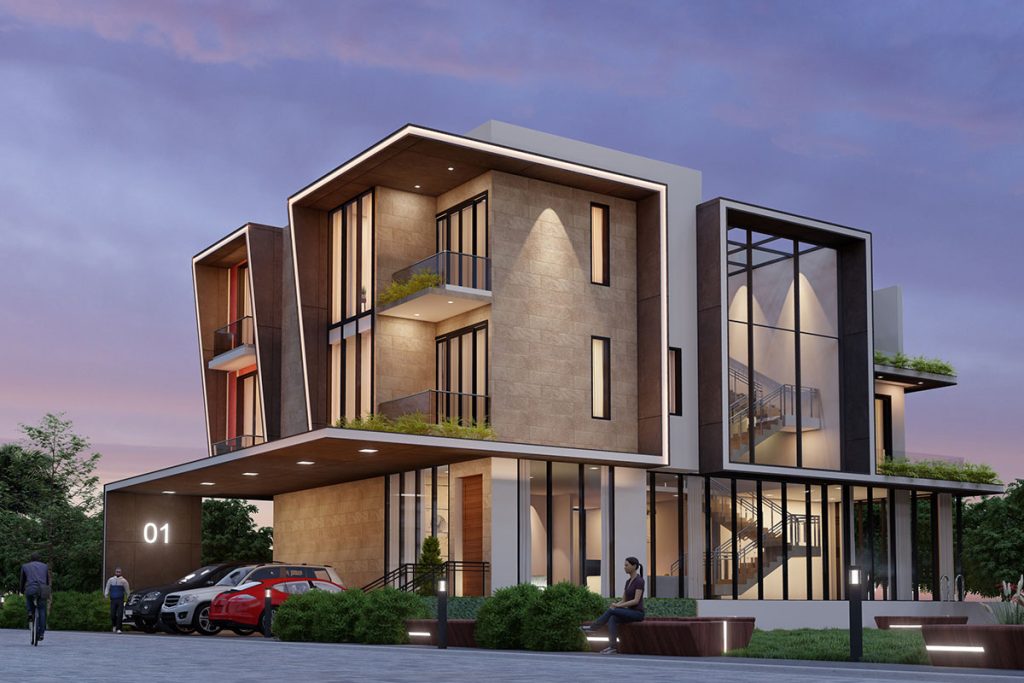
Achieving realistic lighting effects is a cornerstone of high-quality exterior architectural visualization. The way light interacts with a building’s surfaces and the surrounding environment can significantly impact the perception of the design. Realistic lighting enhances the visual appeal, highlights architectural features, and creates an immersive experience for viewers. With advancements in rendering technology and techniques, architects and visualizers now have powerful tools at their disposal to simulate natural and artificial lighting with stunning accuracy.
One of the key aspects of realistic exterior lighting is the accurate representation of natural sunlight and shadows. This includes understanding the position and intensity of the sun at different times of the day and throughout different seasons. Properly rendered sunlight can bring out the textures and materials of a building, adding depth and dimension to the visualization. Additionally, realistic shadows can provide a sense of scale and context, making the overall scene more believable.
Another critical component is the use of artificial lighting to enhance exterior visualizations. Whether it’s streetlights, landscape lighting, or illuminated signage, artificial lighting plays a crucial role in defining the ambiance and functionality of outdoor spaces. The careful placement and intensity of these lights can dramatically alter the mood and perception of the exterior environment.
In architectural 3D visualization, HDRI maps play a crucial role in enhancing the realism of exterior renderings. By selecting appropriate HDRI maps, designers can create renders that accurately capture the desired atmosphere and texture, elevating the overall rendering look. Experimenting with different HDRI maps allows for a deeper understanding of how they influence lighting and reflections in visualization. Adjusting the intensity and positioning of these maps further refines the lighting effects, helping achieve specific aesthetic goals for the exterior visualization.
Experiment with different sun positions to enhance your exterior visualizations. By adjusting the sun angle, you can create captivating shadows and lighting effects that bring your design to life. This technique is crucial in highlighting specific architectural features and adding depth to your project.
Consider the time of day and the desired mood for your exterior visualization. By strategically placing the sun, you can evoke different emotions and atmospheres in your design. Whether you want a warm, inviting feel or a dramatic, dynamic look, playing with sun positions can significantly impact the overall look and feel of your project.
Embrace the use of soft shadows in exterior visualizations to bring a natural and realistic feel to your designs. By adjusting the softness of shadows, you can create various moods and enhance the overall visual appeal. Experimenting with different light sources and angles allows you to achieve the perfect balance of soft shadows, adding depth and dimension to your visualization.
Make sure to pay attention to details such as positive space, negative space, and the placement of elements like people models and trees to avoid falling into common mistakes that can disrupt the harmony of the scene.
Incorporating atmospheric effects such as fog or haze can significantly elevate the realism and depth of exterior visualizations. Experimenting with varying levels of these effects allows for the creation of a compelling sense of distance and scale within the design. By strategically utilizing atmospheric elements, designers can enhance the overall mood and atmosphere portrayed in the exterior visualization.
Enhancing reflections in exterior visualization involves utilizing various types tailored to specific objects and materials, ensuring a realistic outcome. Experiment with reflection settings to attain the desired level of detail, adding depth and authenticity to the design. By adjusting reflection intensity and sharpness, you can create visually appealing visuals that captivate clients and stakeholders alike. This approach serves as an excellent way to highlight focal points and correct any wrong perspectives, providing clients with a clear insight into the final look of the project.
Utilizing physical cameras in exterior visualization allows for a more authentic representation of the design, mimicking real-world camera settings. Experimenting with various camera angles and settings is crucial to finding the optimal composition that highlights the building’s features effectively. Adjusting parameters like focal length and depth of field can significantly enhance the visual appeal and realism of the renderings. By fine-tuning these settings, designers can create visuals that closely align with how the human eye perceives the environment, resulting in compelling and lifelike representations of architectural projects.
Enhance the final look of exterior visualisations by leveraging post-processing techniques. Experiment with colour correction, contrast adjustments, and other effects to improve the rendering’s quality. Utilise post-processing tools to refine details, add depth, and create a polished finish for your exterior visualisation.
Incorporating HDRI maps, experimenting with sun positions, embracing soft shadows, adding atmospheric effects, enhancing reflections, using physical cameras, and leveraging post-processing techniques are key elements for creating stunning exterior visualizations. By following these steps, you can elevate your projects to new heights, captivating your audience with realistic and immersive designs. Remember to pay attention to detail and continuously refine your skills to stay ahead in the competitive field of architectural visualization.
Don’t hesitate to put these tips into practice and witness the transformation in your exterior visualizations. Keep honing your craft, exploring new techniques, and pushing the boundaries of creativity to achieve remarkable results. Your dedication and commitment will set you apart in delivering exceptional visual experiences to your clients and viewers.